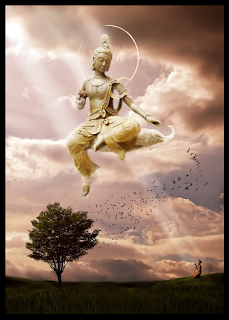 |
| Siddhartha was an ascetic under trees in search of freedom from samsara's seas (Hokusai) |
 |
| Ascetic Sid, Mes Aynak (livescience.com) |
According to the historical Buddha, the "Sage who came from the Shakya clan," if we want to cross over from this shore (samsara) full of danger to the further shore (nirvana) beyond all danger, we need to put together a "raft" (a sufficient understanding of the practice).
We
gather just enough material then we strive
diligently and consistently. We exert just enough effort (viriya), paddling with every limb we have, to cross over to nirvana.
Persistent
balanced-effort is the gradual path the Buddha
taught, or we risk exhausting ourselves and giving up long before we
reach the goal. Or we die
trying by the legendary exertion that gets all the attention (in the
story of the Buddha, of forest dwelling monastics, of patriarchs in
later schools) in spite of
the fact that it does not work to overdo it. Paradoxically, sometimes
the "effort" required is allowing, that is, accepting, non-doing, abandoning the detrimental, letting go of clinging.
Under a sprawling Bodhi tree
 |
| Siddhartha persists but with ease and balance accessing the wealth of the jhanas. |
 |
| Bodhi tree shrine, India (Themeplus) |
Siddhartha did not succeed under the Bodhi tree because he tried so hard: So long as he was trying
that hard, he could not succeed. He succeeded because he eased off,
first accepting help from the maiden Sujata then realizing that jhanas
(blissful and equanimous meditative absorptions) were the way. As an
austere ascetic, he had been so afraid of pleasure and of becoming
attached to it that he had avoided
A sufficient raft is all we need. Even a poorly fabricated raft is enough to get across over the flood (ogha), this sea of samsara. "Enough" concentration is enough, enough insight is enough. The goal exists.
Whether or not we achieve
(patiently allow) absorption, access concentration
may be enough. It becomes the route we take, the one now available to
us. The Buddha's gradual path takes us from virtue to calm (samatha) to effortless-concentration (samma-samadhi).
Even
a flimsy foundation may be just enough support to successfully
practice mindfulness (four foundations or bases) that support wisdom. Liberation
depends on it.
 |
| The swirling, whirling, sucking sea |
If there is time and a suitable teacher, a
more stable platform is helpful. A human life is extraordinarily rare.
It's a terrible thing to waste and a wonderful thing to utilize to
finally see nirvana.
If all one reaches is absorption (jhana), which is purifying by suppressing the defilements, that will lead to a very welcome rebirth.
But the end of all rebirth
and suffering is the goal for those who have understood what the Buddha
taught. So beyond calm, there is liberating-insight to strive for. This breakthrough is accomplished by practicing the factors of Dependent Origination. One thereby sees and undoes suffering. It is only by knowing-and-seeing the Path (magga-phala, "path-and-fruition" consciousnesses) that one awakens to unending peace.
The world is the world is the world
 |
| O, spirit, where shall I sit? - Try that tree (Deen406) |
From this world, it is easy to see dukkha (suffering, disappointment, woe, lack of fulfillment from our many endeavors).
It is also visible from the lower Sensual-Sphere deva
worlds, but on this plane we have drive due to there being reasons
to strive constantly on our heels, urging and reminding us of the dangers: aging, sickness, ignominy, death, rebirth.
The threat of defamation and infamy are very real as we face Eight Worldly Conditions:
- success and failure (gain and loss),
- fame and obscurity,
- praise and blame,
- pleasure and pain.
Who needs "the end of all suffering"? We all would IF we understood what the Buddha meant by dukkha. Some say, "All life is suffering." That is completely wrong -- unless one grasps what "suffering" means as a translation of dukkha.
All the Buddha ever taught, according to him, was suffering and the end
of suffering, disappointment and the end of disappointment, dukkha and nirvana.
The way to nirvana is enlightenment (bodhi).
And the way to enlightenment is mindfulness (as set up moment to moment
and actively developed through contemplative themes outlined in the Maha Satipatthana Sutra). And the way to mindfulness is "meditation" (calm, zen, jhana, serenity, samatha, unification, singlemindedness, absorption, nondistraction, and samma-samadhi or "right concentration"). And the way to meditation is virtue (sila), which imparts peace of mind and non-remorse.
Samsara
is impermanent (ever changing),
unsatisfactory (disappointing), and impersonal. There is great danger
inherent in it for the unenlightened. So we should get enlightened or
into the stream certain to take us to enlightenment as soon as possible.
Danger, what danger?
Until stream entry there is an ever-present danger of falling
into unfortunate realms (rebirth destinations) for indeterminate periods
of time. Then, during those times, one forgets the goal, forgets even the possibility of
there being freedom from suffering, the possibility of awakening from
this miserable dream with nightmare aspects. Continued: Who am I?
































































































































































































































No comments:
Post a Comment